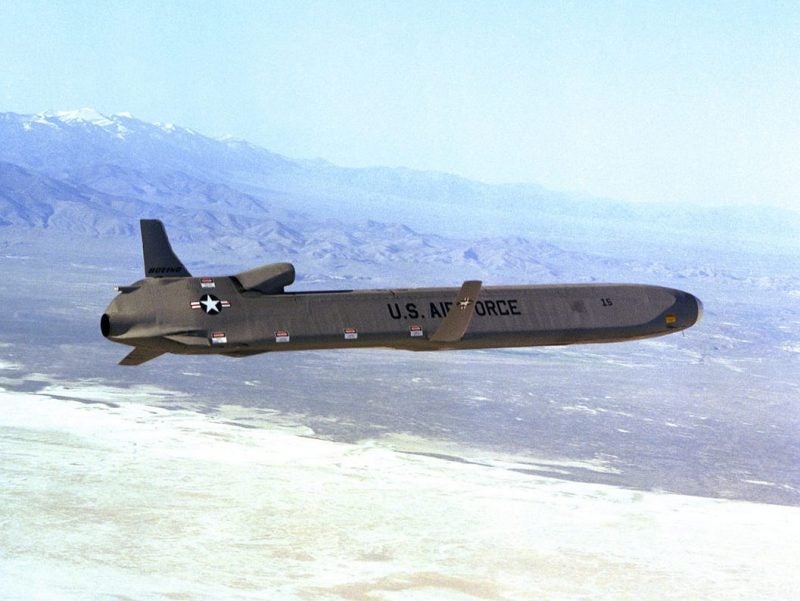
Despite preferring Raytheon’s design, the USAF Nuclear Weapons Centre made clear that shortlisted Lockheed Martin would continue to be a part of the process and that moving forward with Raytheon as a sole-source contractor did not equate to Lockheed being down-selected out of the process.
The move to go ahead with a sole-source acquisition for LRSO means that two of the US Air Force’s nuclear recapitalisation efforts will be developed under sole-source processes following Northrop Grumman’s win-by-default of the project to build the Ground-Based Strategic Deterrent (GBSD). However, the USAF was clear that the ‘off-ramping’ of Lockheed Martin was consistent with the LRSO strategy and was different from Boeing’s decision not to pursue the GBSD contract further.
The USAF said that it decided to move forward with Raytheon’s design following an ‘an extensive evaluation of contractor programmatic and technical approach’ during the programme’s TMRR phase.
US Air Force Nuclear Weapons Centre (AFNWC) LRSO system programme manager Elizabeth Thorn said: “This is not a down-select per se; instead, we are reframing our relationship with Lockheed Martin to focus on specific technology maturation we believe either has future applicability for the final LRSO design or will reduce overall program risk.”
The LRSO programme is now transitioning to progress with a sole-source process and is looking at how funding opportunities can be moved to critical areas and the potential of combining some aspects of the programmes future phases like flight tests into the TMRR phase of the programme.
Thorn added that the LRSO programme office is looking to reallocate recourses between the prime and subcontractor offices.

US Tariffs are shifting - will you react or anticipate?
Don’t let policy changes catch you off guard. Stay proactive with real-time data and expert analysis.
By GlobalDataAFNWC commander and program executive officer for strategic systems Major General Shaun Morris said: “Our competitive TMRR phase, which included both Lockheed Martin and Raytheon as the prime contractors, enabled us to select a high-confidence design at this point in the acquisition process.
“And this early off-ramp of a contractor is completely in line with the existing LRSO acquisition strategy, which included periodic reviews to assess contractor designs. Lockheed Martin has been an excellent contractor and partner throughout the TMRR effort and this pivot to Raytheon does not represent a lack of effort or commitment on their part. Lockheed Martin has supported the nuclear enterprise for decades and we continue to value their expertise in sensors and nuclear certification and surety.”
Raytheon and Lockheed Martin were originally handed separate $900m contracts; the USAF was originally set to decide between the two contractors in 2022.
Morris added: “I am confident in the programme office’s ability to execute the next phase’s contract negotiations in a single-source environment and maintain schedule and affordability.
“We are committed to acquiring an affordable LRSO weapon system and we have exceptional cost and design insight into both contractors’ strategies, due to our progress with the acquisition reviews and the cost-capability trades.”
Negotiations on the contracts engineering and manufacturing development (EMD) phase are set to start in Fiscal Year 2021, with a view to awarding a final contract in 2022, as was first planned.
Raytheon Missiles and Defense president Wes Kremer said: “LRSO will be a critical contributor to the air-launched portion of America’s nuclear triad, providing a modernised capability to the US Air Force will strengthen our nation’s deterrence posture.”
In its release, AFNWC said ‘the LRSO cruise missile is a critical element of the Air Force’s on-going nuclear recapitalization efforts.’
International Institute of Strategic Studies senior fellow for military aerospace Douglas Barrie told Air Force Technology: “The programme is intended to provide the USAF with a survivable long-range cruise missile, intended first for the nuclear role.
“As such, it is a core weapon for the B-21 and will also be integrated on the B-52, and B-2. As well as the primary nuclear role the USAF aspires to acquire conventionally armed variants of the missile.”
The USAF has in the past argued that LRSO is needed to ensure the B-52 can continue to operate, providing the ageing strategic bomber with an air-launched nuclear weapon means the bomber can operate outside enemy airspace, allowing the missile to fly in and strike a target.
Outside of being used to carry a nuclear warhead, LRSO could also potentially be used to carry novel payloads for different effects.
Barrie added: “There is also the potential for the LRSO to carry novel payloads such as a high-power microwave. The LRSO is a replacement for the AGM-86 family, the conventional variant of which was retired at the end of 2019, while the nuclear variant remains in service.
“As such the LRSO is arguably a key project in the USAFs nuclear role and in sustaining the US TRIAD.”



